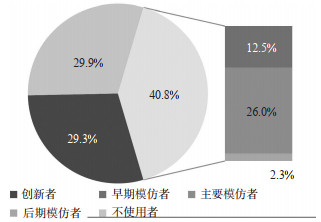User Preferences for Shared Autonomous Vehicles Based on Latent-Class Logit Models
-
摘要: 自动驾驶技术和共享经济融合产生的共享自动驾驶汽车(SAV)可为人们提供优质的出行服务。为探究出行者选择SAV的行为特性,对受访者的社会经济属性、历史出行特性、行为态度特征进行调查,并采用正交试验设计出行方式选择意向调查问卷,收集到311份有效数据。为充分考虑个体异质性,利用潜在类别分析探究SAV使用者的潜在类别,并将所得潜在类别作为变量融入离散选择Logit模型,建立SAV使用意向的潜在类别-Logit模型。结合多项或混合Logit模型以及划分的3个潜在类别,根据4个合理的模型标定的性别、交通模式、SAV使用人群类型、等待时间等59个变量的参数,识别SAV使用意向的显著性影响因素,并采用7个拟合优度指标评价多项Logit、混合Logit、潜在类别-Logit等8个模型。利用边际效应分析,探讨出行方式属性对SAV使用意向的具体影响。结果表明:涉及3个潜在类别的离散选择Logit模型具有更强的解释性,这3个潜在类别可分别描述为冲动的积极创新者、矛盾的保守创新者和理智的保守使用者;不同潜在类别人群的显著性因素存在明显差异,SAV使用人群类型是不同潜在类别人群共有的显著性因素,其中SAV创新者在各个模型中的显著性水平值均小于0.1;潜在类别-Logit模型的第1类和第2类预测正确率比其他Logit模型分别高出5.9%~28.3% 和5.4%~18.5%,可以更好地解释出行者对SAV的使用意向;出行等待时间对出行者选择SAV的影响最大;当SAV选择概率接近于0.5时,轻微降低SAV人均出行费用最易引起选择私人小汽车的出行者转而选择SAV。
-
关键词:
- 智能交通 /
- 共享自动驾驶汽车 /
- 使用意向 /
- 潜在类别-Logit模型
Abstract: Shared autonomous vehicles (SAV), which integrates autonomous driving and shared economy technology, provide people with high-quality travel services. Socio-economic attributes, historical travel characteristics, and behavioral attitude characteristics of the respondents are studied, and a questionnaire of stated preferences for travel mode choice is designed by an orthogonal experiment, then 311 valid data are collected to study their behavior characteristics for choosing SAV. A latent class analysis is carried out to fully consider individual heterogeneity and to explore latent classes of users. Integrating the latent classes as the variables into discrete choice Logit models, latent class-Logit models are formulated to study user's preference for SAV. By combining a multinomial or mixed Logit model with the three latent classes discovered, the significant influencing factors for SAV user preferences are recognized out of 59 variables, including gender, travel mode, SAV user group category, waiting time, etc., calibrated by four reasonable models. Moreover, seven indices of goodness of fit are measured to evaluate the effectiveness of eight models such as multinomial Logit, mixed Logit, and latent class-Logit. The marginal utility analysis is used to investigate the impacts of the attributes of travel mode on SAV preferences. Study results show that the discrete choice Logit models with three latent classes have a higher capacity for explaining the relationship between dependent and independent variables. The three classes can be described as the impulsive and positive innovator, contradictory and conservative innovator, and rational and conservative user respectively. It is also found that the significant influencing factors obviously vary across different latent class groups; the category of SAV users group is a significant factor for all latent class groups, and the significance level of SAV innovators in each model is less than 0.1;the accuracies of the first and second categories predicted by the latent class-Logit model are 5.9%~28.3% and 5.4%~18.5% higher than those predicted by other Logit models respectively.It is also found that waiting time has the greatest impact on travelers' choice of SAV; and when the probability of choosing SAV is close to 0.5, slightly reducing the travel cost of SAV is most effective to attract travelers to use SAV, rather than private cars for travel. -
表 1 SP调查考虑的影响因素及其水平
Table 1. Influencing factors and their levels considered by SP survey
影响因素 出行方式 因素水平值 水平1 水平2 水平3 同行人数/人 1 3 5 等待时间/min PC 5 10 15 SEV 10 15 20 RHSV 4 7 10 SAV 2 4 6 行驶时间/min PC 20 30 40 SEV 20 30 40 RHSV 20 28 36 SAV 18 26 34 出行费用/元 PC 5 15 25 SEV 10 15 20 RHSV 25 30 35 SAV 30 35 40 表 2 社会经济属性各因素分布
Table 2. Distribution of each factor of socio-economic attributes
因素 取值 占比/% 性别 男,女 48.2, 1.8 年龄/岁 18~30, > 30~40, > 40~60, > 60 55.6, 30.6, 12.2, 1.6 学历 高中及以下,大专,本科,硕士,硕士以上 19.0, 10.0, 37.9, 26.4, 6.7 职业 学生,工作者,失业/待业,家庭主妇/夫,退休 40.5, 50.2, 4.5, 3.2, 1.6 驾龄/年 无驾照,有驾照而无驾驶经验,0~1,1~5, > 5 21.9, 21.9, 7.7, 26.6, 21.9 小汽车拥有量/辆 0, 1, > 1 52.4, 37.9, 9.7 是否有12岁以下儿童 是,否 28.3, 1.7 月收人/元 < 3 000, > 3 000~6 000, > 6 000~10 000, > 10 000 47.6, 23.1,14.5, 4.8 表 3 历史出行特性和行为态度特征外显变量及其取值
Table 3. Manifest variables and their values of historical travel characteristics and behavioral attitude characteristics
外显变量 取值 历史出行特性 历史出行模式 舒适小汽车,经济公共交通 主要出行目的 出勤,退勤,外出业务/出差,休闲娱乐,赴约 行为态度特征 对SAV了解程度 深人了解,一般了解,不了解 对SAV发展态度 积极型,保守型,担忧型,拒绝型 SAV使用人群 不使用者,创新者,早期模仿者,主要模仿者,后期模仿者 SAV数量占比/% 0, 30, 60, 90, 100 政策指定的影响 无影响,积极影响 表 4 不同Logit模型对社会经济属性的参数标定结果
Table 4. Results of parameter calibration for different Logit models for socio-economic attributes
变量名称 模型参数值 MNL-IPI MNL-CCI MNL-RCU MIXL-RCU SEV常数项a -5.07*** 23.31 0.09 0.38 RHSV常数项a -5.4*** -0.92 0.28 -0.60 SAV常数项a -5.51*** 18.86 -3.59*** -5.03*** SEV女性h -1.14* 0.86** -0.01 -0.13 RHSV女性h -0.78 0.53* 0.25 0.41 SAV女性h -0.52 -0.42 0.64** 0.56 SEV超过29岁c 2.94*** 0.07 RHSV超过29岁c 0.26 0.93** SAV超过29岁c 1.40 1.06** SEV高中及以下d 0.33 RHSV高中及以下d -0.18 SAV高中及以下d 0.91 SEV本科e 0.38 0.49 RHSV本科e 0.62*** 0.73** SAV本科e 0.85*** 1.09*** SEV工作者f -0.82 0.41 0.70 0.65 RHSV工作者f -0.16 1.01 -0.36 -0.48 SAV工作者f -0.06 -0.51 -0.37 -0.72 SEV无业f -39.29 -2.28*** -3.09*** RHSV无业f 1.21 -19.75 -16.75 SAV无业f -17.92 -18.24 -15.24 SEV有驾驶经验g -0.88 -0.44 0.47** 0.89** RHSV有驾驶经验g -0.04 -0.08 0.14 0.40 SAV有驾驶经验g 0.57 -1.59*** -1.09*** -1.56*** SEV有私家车h -3.77*** -1.23 0.27 0.61 RHSV有私家车h -1.52** -2.03*** 0.48 1.02 SAV有私家车h -4.00*** 0.21 0.06 0.13 SEV有儿童i 0.95** -0.82 -1.26 RHSV有儿童i -0.27 -1.66** -2.37** SAV有儿童i -0.19 -1.54* -2.01** SEV中收人j 0.12 -25.06 -0.87* -1.12* RHSV中收人j -1.60** -0.62 0.19 0.20 SAV中收人j -0.98 -20.35 0.78 1.17 SEV高收人j -24.69 -0.43 0.33 RHSV高收人j 0.07 0.74 1.53 SAV高收人j -20.98 -16.42 -13.42 注:a参考项为PC; b参考项为男性; c参考项为29岁及以下; d参考项为本科及以上; e参考项为非本科; f对MNL-IPI模型参考项为非工作者,对非MNL-IPI模型参考项为学生; g参考项为无驾照或有驾照而无驾驶经验; h参考项为无私家车; i参考项为无12岁以下儿童; j对MNL-IPI模型参考项为非中收入,对非MNL-IPI模型参考项为低收入; ***、**和*分别表示显著性水平为0.01、0.05和0.10时该项为显著性因素。 表 5 不同Logit模型对历史出行特性、行为态度特征和出行方式属性的参数标定结果
Table 5. Results of parameter calibration for different Logit models for historical travel characteristics, behavioral attitude characteristics and travel mode attributes
变量名称 模型参数值 MNL-IPI MNL-CCI MNL-RCU MIXL-RCU SEV经济公共交通模式a 3.10*** 1.71*** RHSV经济公共交通模式a 2.65** 0.91*** SAV经济公共交通模式a 1.03 -0.01 SEV其他目的b 1.52*** 0.41 -0.17 -0.38 RHSV其他目的b 0.28 0.99*** -0.55*** -0.81** SAV其他目的b 1.34* 0.52** 0.36 0.41 SEV了解SAVc 0.51 0.21 -0.23 -0.12 RHSV了解SAVc 0.95 0.23 0.06 0.34 SAV了解SAVc 1.78*** 0.82** -0.26 -0.32 SEV创新者d 1.67* -0.37 0.26 0.22 RHSV创新者d 2.11** 0.30 -0.60 -1.06* SAV创新者d 2.03* 0.90** 1.72*** 2.44*** SEV模仿者d -0.13 -0.29 0.38 0.24 RHSV模仿者d 1.40 0.76** -0.65*** -1.04** SAV模仿者d 0.06 0.15 0.64* 0.90** SEV同行人数d 0.07 -0.25** -0.26*** -0.35*** RHSV同行人数d 0.45*** -0.16 -0.18** -0.09 SAV同行人数d 0.20 0.23*** 0.48*** 0.72*** 等待时间 0.04 -0.04** -0.05*** -0.07*** 行驶时间 -0.01 0.00 -0.01 0.00 人均出行费用 0.03 -0.01 -0.04*** -0.04 等待时间标准差 0.30*** 人均出行费用标准差 0.30*** 注:人均出行费用为出行费用与同行人数之比; a参考项为舒适小汽车模式; b参考项为通勤; c参考项为不了解SAV; d参考项为不使用者; ***、**和*分别表示显著性水平为0.01、0.05和0.10时该项为显著性因素。 表 6 不同Logit模型的拟合优度
Table 6. Goodness-of-fit of different Logit models
参数 Logit模型 MNL MIXL MNL-IPI MNL-CCI MNL-RCU MIXL-RCU MNL-LC MIXL-LC 零模型所得极大似然比 0.123 0.128 0.284 0.251 0.149 0.164 0.184 0.204 常数模型所得极大似然比 0.080 0.085 0.250 0.162 0.119 0.134 0.144 0.165 零模型调整的极大似然比 0.092 0.097 0.142 0.180 0.096 0.110 0.155 0.175 常数模型调整的极大似然比 0.049 0.054 0.110 0.087 0.067 0.082 0.115 0.135 第1类预测正确率/% 45.0 45.0 31.9 22.7 31.3 31.3 50.9 51.0 第2类预测正确率/% 34.0 34.3 31.6 21.4 30.2 29.6 39.7 39.9 AIC值 3 517.200 3 499.000 544.800 1 180.280 1 627.340 1 600.720 3 273.584 3 196.794 表 7 总样本对应的出行方式属性的平均边际效应
Table 7. Average marginal utility of various travel mode attributes corresponding to all the samples
出行方式 变化的属性 属性增加值 出行方式选择概率的变化率/% PC SEV RHSV SAV 私人小汽车 等待时间/min 1 -0.95 0.29 0.38 0.28 行驶时间/min 1 -0.09 0.03 0.04 0.03 人均出行费用/(元/人) 1 -0.43 0.13 0.17 0.13 共享电动汽车 等待时间/min 1 0.29 -0.58 0.17 0.12 行驶时间/min 1 0.03 -0.05 0.02 0.01 人均出行费用/(元/人) 1 0.13 -0.27 0.08 0.06 网约车 等待时间/min 1 0.38 0.17 -0.71 0.16 行驶时间/min 1 0.04 0.02 -0.07 0.02 人均出行费用/(元/人) 1 0.17 0.08 -0.32 0.07 共享自动驾驶汽车 等待时间/min 1 0.28 0.12 0.16 -0.56 行驶时间/min 1 0.03 0.01 0.02 -0.05 人均出行费用/(元/人) 1 0.13 0.06 0.07 -0.26 表 8 不同类型SAV使用人群对应的SAV属性的平均边际效应
Table 8. Average marginal utility of the attributes of SAV for different kinds of SAV users
SAV使用人群类型 变化的属性 属性增加值 出行方式选择概率的变化率/% PC SEV RHSV SAV 创新者 等待时间/min 1 0.27 0.11 0.12 -0.50 行驶时间/min 1 0.05 0.02 0.02 -0.09 人均出行费用/(元/人) 1 0.06 0.03 0.03 -0.12 模仿者 等待时间/min 1 0.33 0.20 0.23 -0.76 行驶时间/min 1 0.03 0.02 0.02 -0.07 人均出行费用/(元/人) 1 0.17 0.10 0.11 -0.38 不使用者 等待时间/min 1 0.32 0.10 0.20 -0.62 行驶时间/min 1 0.02 0.01 0.01 -0.04 人均出行费用/(元/人) 1 0.16 0.05 0.10 -0.31 -
[1] 李克强, 戴一凡, 李升波, 等. 智能网联汽车(ICV)技术的发展现状及趋势[J]. 汽车安全与节能学报, 2017, 8(1): 1-14. doi: 10.3969/j.issn.1674-8484.2017.01.001LI K Q, DAI Y F, LI S B, et al. State-of-the-art and technical trends of intelligent and connected vehicles[J]. Journal of Au-tomotive Safety and Energy, 2017, 8(1): 1-14. (in Chinese) doi: 10.3969/j.issn.1674-8484.2017.01.001 [2] KRUEGER R, RASHIDI T H, ROSE M J. Preferences for shared autonomous vehicles[J]. Transportation Research Part C: Emerging Technologies, 2016(69): 343-355. [3] FAGNANT D J, KOCKELMAN K M. The travel and environmental implications of shared autonomous vehicles, using agent-based model scenarios[J]. Transportation Research Part C: Emerging Technologies, 2014(40): 1-13. [4] LANG N S, RUESSMANN M, COLLIE B E, et al. Reshaping urban mobility with autonomous vehicles: Lessons from the city of Boston[R]. Geneva: World Economic Forum, 2018. [5] SALAZAR M, ROSSI F, SCHIFFER M, et al. On the interaction between autonomous mobility-on-demand and public transportation systems[C]. 2018 IEEE Intelligent Transportation Systems Conference(ITSC), Maui, Hawaii, USA, 2018. [6] CHILDRESS S, NICHOLS B, COE S. Using an activity-based model to explore possible impacts of automated vehicles[J]. Transportation Research Record, 2015(2493), 99-106. [7] ZHANG W, GUHATHAKURTA S, FANG J, et al. Exploring the impact of shared autonomous vehicles on urban parking demand: An agent-based simulation approach[J]. Sustainable Cities and Society, 2015(19): 34-45. [8] WEBB J, WILSON C, KULARATNE T. Will people accept shared autonomous electric vehicles? A survey before and after receipt of the costs and benefits[J]. Economic Analysis Policy, 2019(61): 118-135. [9] NAZARI F, NORUZOLIAEE M, MOHAMMADIAN A. Shared versus private mobility: Modeling public interest in autonomous vehicles accounting for latent attitudes[J]. Transportation Research Part C: Emerging Technologies, 2018(97): 456-477. [10] 姚荣涵, 梁亚林, 刘锴, 等. 考虑合乘的共享自动驾驶汽车选择行为实证分析[J]. 交通运输系统工程与信息, 2020, 20 (1): 228-233. https://www.cnki.com.cn/Article/CJFDTOTAL-YSXT202001035.htmYAO R H, LIANG Y L, LIU K, et al. Empirical analysis of choice behavior for shared autonomous vehicles with concern of ride-sharing[J]. Journal of Transportation Systems Engineering and Information Technology, 2020, 20(1): 228-233. (in Chinese) https://www.cnki.com.cn/Article/CJFDTOTAL-YSXT202001035.htm [11] WANG K L, AKAR G. Factors affecting the adoption of autonomous vehicles for commute trips: An analysis with the 2015 and 2017 Puget Sound travel surveys[J]. Transportation Research Record, 2019, 2673(2): 13-25. doi: 10.1177/0361198118822293 [12] PHILIPSEN R, BRELL T, ZIEFLE M. Carriage without a driver: User requirements for intelligent autonomous mobility services[C]. AHFE 2018 International Conference on Hu- man Factors in Transportation, Orlando, Florida, USA: AHFE, 2019. [13] EL ZARWI F, VIJ A, WALKER J L. A discrete choice framework for modeling and forecasting the adoption and diffusion of new transportation[J]. Transportation Research Part C: Emerging Technologies, 2017(79): 207-223. [14] 李继朴, 贺宜, 孙昌鑫, 等. 基于SEM的自动驾驶汽车接受度模型与风险分析[J]. 交通信息与安全, 2021, 39(1): 26-34. doi: 10.3963/j.jssn.1674-4861.2021.01.0004LI J P, HE Y, SUN C X, et al. An acceptance model and risk analysis of automated vehicles based on SEM[J]. Journal of Transport Information and Safety, 2021, 39(1): 26-34. (in Chinese) doi: 10.3963/j.jssn.1674-4861.2021.01.0004 [15] 刘志伟, 刘建荣, 邓卫. 考虑潜在类别的市内机动化出行行为模型[J]. 西南交通大学学报, 2021, 56(1): 131-137. https://www.cnki.com.cn/Article/CJFDTOTAL-XNJT202101017.htmLIU Z W, LIU J R, DENG W. Motorized travel in the city analysis considering the latent classes[J]. Journal of Southwest Jiaotong University, 2021, 56(1): 131-137. (in Chi-nese) https://www.cnki.com.cn/Article/CJFDTOTAL-XNJT202101017.htm [16] 邱皓政. 潜在类别模型的原理与技术[M]. 北京: 教育科学出版社, 2008.QIU H Z. Latent class modeling: Principles and tech- niques[M]. Beijing: Educational Science Publishing House, 2008. [17] CLOGG C C. Some latent structure models for the analysis of Likert-type data[J]. Social Science Research, 1979, 8(4): 287-301. doi: 10.1016/S0049-089X(79)80001-0 [18] 乔珂, 赵鹏, 文佳星. 基于潜在类别模型的高铁旅客市场细分[J]. 交通运输系统工程与信息, 2017, 17(2): 28-34.QIAO K, ZHAO P, WEN J X. Passenger market segmentation of high-speed railway based on latent class model[J]. Journal of Transportation Systems Engineering and Information Technology, 2017, 17(2): 28-34. (in Chinese) [19] 关宏志. 非集计模型: 交通行为分析的工具[M]. 北京: 人民交通出版社, 2004.GUAN H Z. Disaggregate model-tool for traffic behavior analysis[M]. Beijing: China Communications Press, 2004. [20] BEN-AKIVA M, LERMAN S R. Discrete choice analysis[M]. London: The MIT Press, 1997. [21] 唐立, 邹彤, 罗霞, 等. 基于混合Logit模型的网约车选择行为研究[J]. 交通运输系统工程与信息, 2018, 18(1): 108-114.TANG L, ZOU T, LUO X, et al. Choice behavior of taxi-hail-ing based on Mixed-Logit model[J]. Journal of Transportation Systems Engineering and Information Technology, 2018, 18(1): 108-114. (in Chinese) -





 下载:
下载:




